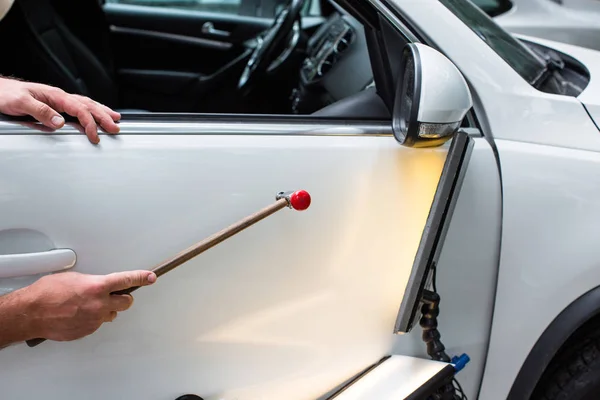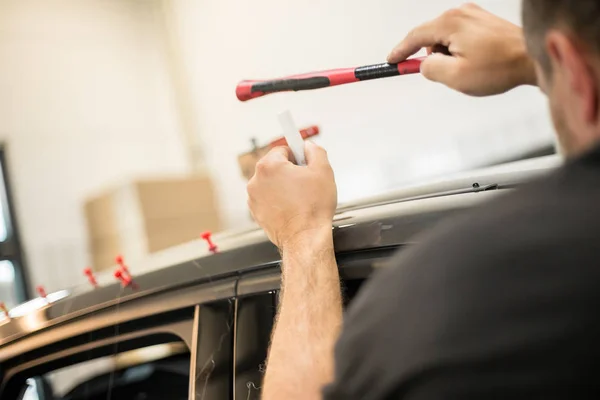Essential Auto Body Dent Repair Techniques To Remove Dents Without Damaging Your Paint
Dents are a common nuisance for vehicle owners, whether caused by hail, minor collisions, or even shopping carts. Repairing these dents can be tricky, especially when trying to avoid damaging the vehicle's paint. Fortunately, there are several techniques that auto body dent repair professionals use to remove dents effectively without harming the finish. This article will explore the most essential methods for dent repair, focusing on preserving the integrity of the paintwork.
Understanding the Basics of Dent Repair
Before diving into specific techniques, it is essential to understand the fundamentals of dent repair. When a dent occurs, the metal of the car's body is displaced but not necessarily damaged in a way that compromises its structure. The goal of dent repair is to restore the original shape of the metal without causing additional damage to the paint. This requires a careful approach, as the paint layer is thin and can easily crack or chip during the repair process.
Paintless Dent Repair (PDR)
What is Paintless Dent Repair?
Paintless Dent Repair (PDR) is a specialized technique used to remove dents and dings from a vehicle's body without the need for repainting. This method is most effective for shallow dents where the paint has not been damaged. Technicians access the backside of the dent using specialized tools to carefully massage the metal back into its original shape. PDR preserves the factory finish and helps maintain the vehicle's value, making it a popular choice among car owners.
How Does PDR Work?
Paintless Dent Repair (PDR) works by utilizing specialized tools to access the back of the dented area. Technicians use a combination of light and reflection to identify the precise location and depth of the dent. By gently pushing or pulling the metal back into its original shape, they can restore the surface without affecting the paint. This meticulous process requires skill and a deep understanding of metal properties to achieve a flawless finish.

Advantages of PDR
The advantages of Paintless Dent Repair (PDR) include preserving the vehicle's original paint, which maintains its value and appearance. This method is typically faster and more cost-effective than traditional repair techniques since it avoids the need for repainting and extensive bodywork. PDR is also environmentally friendly, as it reduces the use of paints and solvents. Additionally, since the process is non-invasive, it minimizes the risk of further damage to the vehicle’s finish.
Traditional Dent Repair Techniques
- Assessment and Preparation: Technicians begin by thoroughly examining the dent to determine the extent of the damage. This step often involves cleaning the area and assessing whether the dent can be repaired using paintless methods or if traditional techniques are necessary.
- Body Filler Application: For deeper dents or areas with paint damage, technicians sand down the affected area to prepare it for body filler. The filler is then applied to restore the panel's shape, allowing for subsequent sanding to achieve a smooth surface.
- Sanding and Finishing: Once the filler has cured, technicians meticulously sand the area to blend it seamlessly with the surrounding metal. This step is crucial for ensuring that the repair is smooth and even, allowing for a flawless repaint.
- Repainting and Final Touches: After the repair area is prepared, a color-matching process is used to repaint the surface. Technicians apply several coats of paint and a clear coat to protect the finish, ensuring the repair blends well with the original paint job for a seamless appearance.
Heat and Cooling Techniques
Utilizing Heat for Dent Removal
Utilizing heat for dent removal involves applying controlled heat to the dented area, allowing the metal to expand and relieve tension. Technicians use heat guns or hair dryers while carefully monitoring the paint's temperature to prevent damage. After heating, a cooling agent like compressed air is applied to help the metal contract, often popping the dent back into its original shape.

The Process of Heat Application
The process of heat application involves warming the dented area with heat guns or hair dryers to facilitate the metal's expansion. Technicians carefully monitor the temperature to avoid damaging the paint, ensuring it reaches the right level for effective dent removal. After heating, they apply a cooling agent, such as compressed air, which causes the metal to contract and often pops the dent back into its original shape.
Effectiveness and Limitations
Heat application for dent removal is effective for shallow, rounded dents where the paint is intact, allowing the metal to expand and contract. However, it has limitations, as it may not work on sharp creases or deep dents that require more extensive repair methods. If the paint is already damaged, heating can worsen the condition, so technicians must carefully assess each dent before proceeding.
Vacuum Dent Repair
The Principle of Vacuum Dent Repair
The principle of vacuum dent repair relies on creating a suction effect to pull out dents from the vehicle's surface. Technicians use specialized suction tools that adhere to the dented area, allowing them to gently pull on the metal and restore its original shape. This non-invasive method is particularly effective for larger, shallow dents without paint damage, minimizing the risk of further harm to the vehicle's finish.
Implementation of Vacuum Dent Repair
Implementation of vacuum dent repair involves placing a specialized suction tool directly over the dented area to create a strong vacuum seal. Once secured, technicians gently pull on the tool to encourage the metal to return to its original shape. This method is often combined with heat application for better results, making it an effective and non-invasive solution for certain types of dents.
Dent Werx Paintless Dent Repair
Houston, Texas - United States
Phone: +1-832-275-4374

